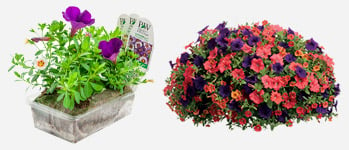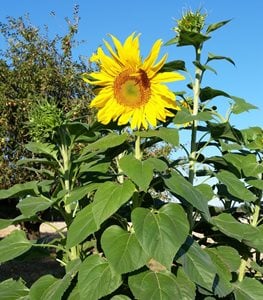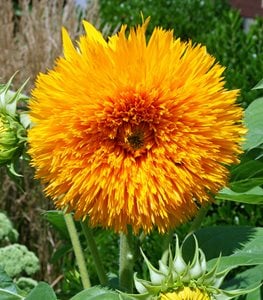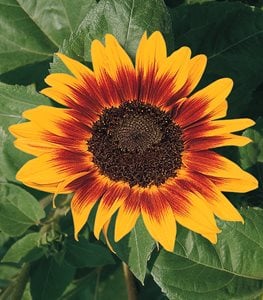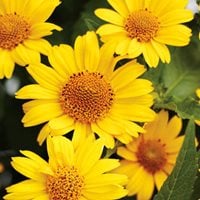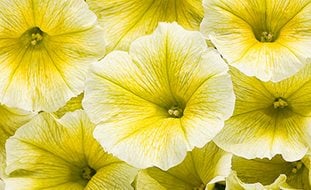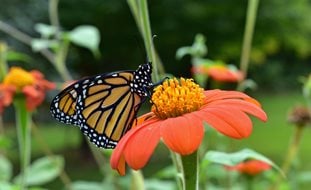Sunflower Care & Planting - Growing Sensational Sunflowers
Learn how to grow and care for these spectacular flowers in your garden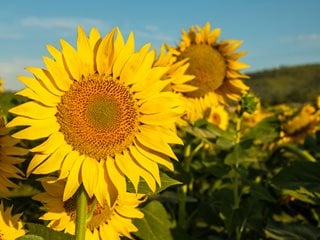
Photo by: Pablesku / Shutterstock.
Sunflowers are iconic, easy-to-grow plants enjoyed by gardeners in every state. One of the easiest flowers to grow, Helianthus thrive in full sun and aren’t picky about soil. You’re probably most familiar with the giant types that grow very tall and have oversized yellow flowers. But there are many other types of sunflowers to explore.
On this page: Basics | Growing Tips | Care and Maintenance | Varieties | Design Ideas | Frequently Asked Questions | Harvest Sunflower Seeds
On this page:
- BASICS
- GROWING SUNFLOWERS
- SUNFLOWER CARE AND MAINTENANCE
- VARIETIES OF SUNFLOWERS
- DESIGN IDEAS
- FREQUENTLY ASKED QUESTIONS
- HARVEST YOUR OWN SUNFLOWER SEEDS
BASICS
Botanical name:
Helianthus spp.
Hardiness Zones:
Usually grown as annuals; perennial varieties 4-8 depending on cultivar
Height:
Varies; giant varieties up to 16 feet tall, dwarf varieties 1 to 4 feet tall
Exposure:
Full sun, 6+ hours per day
When do sunflowers bloom?
Annual sunflowers bloom during summer and into autumn. Sow new plants every few weeks and you’ll enjoy non-stop flowers until the first frost. Perennial sunflowers bloom for a period of 8-12 weeks with some beginning as early as July and others finishing as late as October.
GROWING SUNFLOWERS
When to plant:
For annual sunflowers (Helianthus annuus), sow seeds outdoors after the threat of frost has passed. If you have a short growing season they can be started indoors. Perennial sunflowers should be planted in spring or fall
Soil:
Any; clay, sandy, silt or loam.
Spacing:
For giant sunflowers, or those grown for seed production, sow seeds 2 to 3 feet apart. For smaller annual types popular for cut flower gardens, you can sow seeds about 6 inches apart.
SUNFLOWER CARE
Watering:
Once established, they will tolerate some drought. However, in the periods before, during and after flowering, they perform best with deep, regular watering.
Fertilizing:
In most cases, they will not need fertilizer. However, if your soil is very poor you can use a slow-release granular fertilizer to encourage larger flowers. Be careful - too much nitrogen can inhibit flowering.
Staking:
Sunflowers that grow over 3 feet tall or have large, heavy flower heads are vulnerable to flopping or even breaking under the stress of summer winds and rain. Loosely attach your plant’s branches to stakes with cloth or twine to prevent this problem. Sunflowers grown from seed sown directly in the garden will have well-established roots and stronger stems and be less likely to fall.
To further encourage proper root growth, provide well-draining, organically-rich soil, and plenty of space between plants. And don’t forget to water deeply so that the roots will grow down rather than out.
SUNFLOWER VARIETIES
GIANT
Height: 9 to 16 feet tall
Bloom size: 10 to 14+ inches across
These annual plants boast giant flowers, sometimes measuring more than a foot across. They make a good screen or backdrop and attract all sorts of pollinators. Some varieties have edible seeds. Most need staking to prevent them from falling over in the wind or rain.
Grow these:
- H. annuus 'American Giant'
- H. annuus 'Russian Mammoth'
- H. annuus 'Mammoth Grey Stripe'
DWARF
Height: 1 to 4 feet tall
Bloom size: 2 to 10 inches across
Dwarf sunflowers are good for containers or small gardens. Many dwarf types are branching and offer multiple blooms per plant. Some are double-flowered, some are bicolored, and some are pollenless. Dwarf sunflowers are the perfect size for cutting and using in arrangements.
Grow these:
- Suncredible® Yellow (Helianthus hybrid) — Buy from Proven Winners
- H. annuus 'Solar Flash'
- H. annuus 'Suntastic Yellow'
DOUBLE
Height: 2 to 6 feet tall
Bloom size: 4 to 8 inches across
Known for their fuzzy, fluffy, or soft texture, double sunflowers are attention grabbers. Available in semi-double or fully-double forms, their flowers last longer than single-bloom varieties and make excellent cut flowers. Many are pollenless or have minimal pollen.
Grow these:
- H. annuus 'Teddy Bear'
- H. annuus 'Greenburst'
PERENNIAL
Zones: 4-9
Height: 1 to 10 feet tall
Bloom size: 2 to 5 inches across
Perennial sunflowers will come back year-after-year. They are tough plants that offer 8-12 weeks of flowers. Rather than sending up a giant flower head, like many of the annual types, these sunflowers form clumps with many smaller flowers.
Grow these:
- Helianthus ‘Lemon Queen’
- Helianthus xmultiflorus ‘Capenoch Star’
- H. salicifolius ‘First Light’
SPECIALTY
Height: 4 to 7 feet tallBloom size: 4 to 8 inches across
Many gardeners are surprised to discover that sunflowers are available in more colors than the classic bright yellow. There are types with deep red flowers, others that show of beautiful combinations of color and still others that are white.
Grow these:
- Red: H. annuus ‘Velvet Queen’ or ‘Chianti’
- Bicolor: H. annuus 'Ring of Fire' (pictured) or 'Candy Mountain'
- White: H. annuus 'Coconut Ice' or 'Italian White'
- Mixed: H. annuus 'Autumn Beauty' or 'Music Box'
FALSE SUNFLOWERS
False sunflowers resemble smaller versions of true sunflowers, but have raised, cone-shaped centers. The petals stay with the flower instead of withering and falling off, as sunflowers do. False sunflowers are perennials and can be easily grown in zones 3-9.
'TUSCAN SUN' (pictured) — Buy now from Proven WinnersSize: 2 to 3 feet tall, up to 2 feet wide
'TUSCAN GOLD' — Buy now from Proven Winners. Size: 24 to 32 inches tall, up to 2 feet wide
DESIGN IDEAS
- Grow them as a joyful addition to the late-summer garden. They look great in the back of the border or along a fence or wall.
- Add them to your cutting garden and use them in arrangements. Look for sunflowers that are pollenless and have sturdy stems.
- Use them to attract birds, bees and butterflies-they are great for pollinators while in bloom, and their seed heads can be dried and set out for the birds during winter.
- Plant them as a companion plant in vegetable gardens. The sunflower is the fourth sister that Native Americans used to accompany corn, beans and squash.
- Grow sunflowers to inspire, delight and educate children. Kids are amazed at how quickly they grow and how enormous the giant types become.
FREQUENTLY ASKED QUESTIONS
Are sunflowers poisonous to cats or dogs?
If your pets eat your sunflowers or their seeds, don’t worry because they are non-toxic. You can safely grow them in your garden and use them in arrangements indoors. See more safe plant options: 20 Common Plants Safe for Cats & Dogs.
Do sunflowers follow the sun?
Young sunflowers face east to soak up sunlight in the morning and track the sun as it moves westward throughout the day. This process is called heliotropism. Once sunflowers have reached maturity, they stop following the sun and face east from then on.
Are sunflowers weeds?
Sunflowers are known for popping up on their own (well, actually with the help of birds). For some gardeners they are a treasured surprise, but to others they are a frustrating weed. If you don’t want sunflowers in your garden, simply pull them up, making sure to get the roots.
HARVEST YOUR OWN SUNFLOWER SEEDS
If you want to harvest sunflower seeds to snack on (or to feed the birds with later), plant larger varieties of Helianthus annuus (annual sunflower) since they have the biggest seeds. Good choices are ‘Russian Mammoth’, ‘Sunzilla’, and ‘Heirloom Titan’, sometimes towering more than 10 feet tall with seed heads a foot or more across. (Note: In order for pollen-free Helianthus annuus varieties to form seeds for wildlife, you also need to plant types of sunflowers that produce pollen.)
Harvesting your own seeds is simple:
- When flower heads start to dry and turn to face the ground and seeds are plump and ripe, cut off flower heads with a 2-foot section of the stem attached.
- Tie cheesecloth over the heads and hang them upside-down in a garage or garden shed to finish drying.
If you’re just planning on letting birds feast on the seeds, you can leave the seed heads on the plants for the birds to eat. Another option is to cut the drying ripe seed heads and hang them upside down on a fence to give birds easier access.
